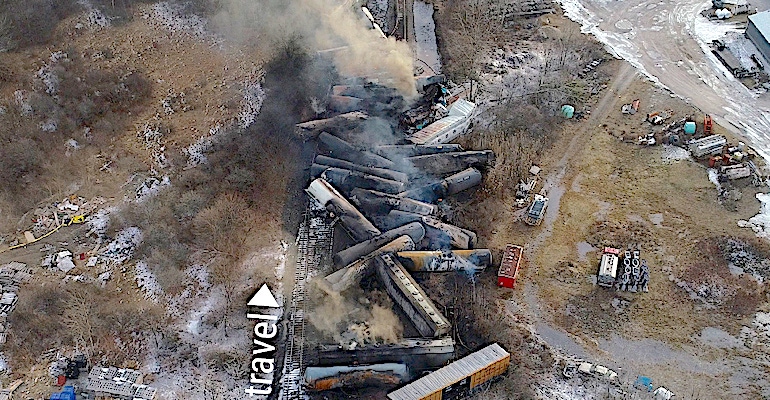A wheel bearing on the Norfolk Southern 32N train overheated between two of the trackside temperature sensor stations before its disastrous failure.

According to the preliminary report from the National Transportation Safety Board (NTSB), an overheated wheel bearing led to the derailment of the freight train in East Palestine, Ohio.
Investigators found that a bearing on the 23rd car of train 32N was overheating thanks to the “hot box” detector installed in the track. This system warned the train’s crew of the condition as designed, but the trail derailed while they were stopping it.
Operator Norfolk Southern employs a system of hot box detectors on the Fort Wayne Line, where the accident happened. According to the Villanova Center for Analytics of Dynamic Systems, there are more than 6,000 wayside detectors in North America dedicated to identifying defective rail vehicle components, including wheels, bearings, and truck systems.
Most of these wayside monitoring systems are hot-bearing detectors, the school says in its Rail Vehicle Diagnostics report. These trackside sensors use non-contact infrared temperature sensors to monitor the bearing housing temperature as rail vehicles pass by. When the bearing temperature exceeds a threshold (typically 220° F (105° C) above ambient) the system triggers an alert.
Such a temperature buildup occurs only under severe faulty conditions, says Villanova. That was the case in this derailment, according to the NTSB. The board found that at milepost 79.9, the suspect bearing from the 23rd car had a recorded temperature of 38°F above ambient temperature. By milepost 69.01 when the train passed the next hot box detector, the bearing’s recorded temperature was 103°F above ambient. Twenty miles later while passing a third hot box detector, the suspect bearing’s temperature had rocketed to 253°F above ambient and the alarm sounded.
Norfolk Southern’s HBD alarm thresholds (above ambient temperature) and criteria for bearings are:
Between 170°F and 200°F, warm bearing (non-critical); stop and inspect
A difference between bearings on the same axle greater than or equal to 115°F (non-critical); stop and inspect
Greater than 200°F (critical); set out railcar
The second HBD’s observation of 103°F above ambient was insufficient to trigger an alert, and by the next detector, the situation was already out of control.
Continuous monitoring could have warned the train’s crew sooner, and that is a possibility.
Writing in Global Railway Review, then-Bombardier Transportation (the rail division is now a part of French company Alstom), Product Manager for Mechatronics Volker Brundisch, at Bombardier Transportation outlined three methods of monitoring the condition of rolling stock.
Permanent On-board Monitoring (POM)
Temporary On-board Monitoring (TOM)
Permanent Trackside Monitoring (PTM)
The first two, POM and TOM, could provide continuous monitoring, but instrumenting all the rolling stock gets expensive. Furthermore, the likelihood of failure because of regularly scheduled maintenance and rebuilds renders the return on this investment low. “POM is especially interesting from an engineer’s point-of-view, rather than from a shareholder’s point-of-view for the vehicle owner,” Brundisch notes.
TOM seems unwieldy, as it necessitates swapping the monitoring equipment among rail cars and having those cars out of service while the work is performed. PTM, on the other hand, can never provide the same precision and continuity of POM, but the rarity of catastrophic failures and the cost of instrumenting every rail car make POM a tough call, Brundisch concludes.
Bearing manufacturer and rebuilder Timken points out that regularly servicing bearings through as many as five rebuilds can keep a rail wheel bearing in service for half a century, calling this an example of economic circularity. “The practice reduces environmental impacts and continues a long tradition of making the most of valuable parts and materials rather than automatically replacing old with new,” the company states on its blog.
The turnaround time for a bearing rebuild is 7-10 days according to the company, which compares to waiting for between six weeks and three months for new ones. Not only that, but the warranty from Timken is the same for rebuilt bearings as it is for new ones. “Why would you toss a perfectly good bearing that just needs minor work?” asked Tony Koesters, who manages Timken’s North America Rail Services division. “By salvaging the bulk of the bearing, you reduce raw materials by about 81 percent, eliminating the energy required to produce them.”
About the Author(s)
You May Also Like





